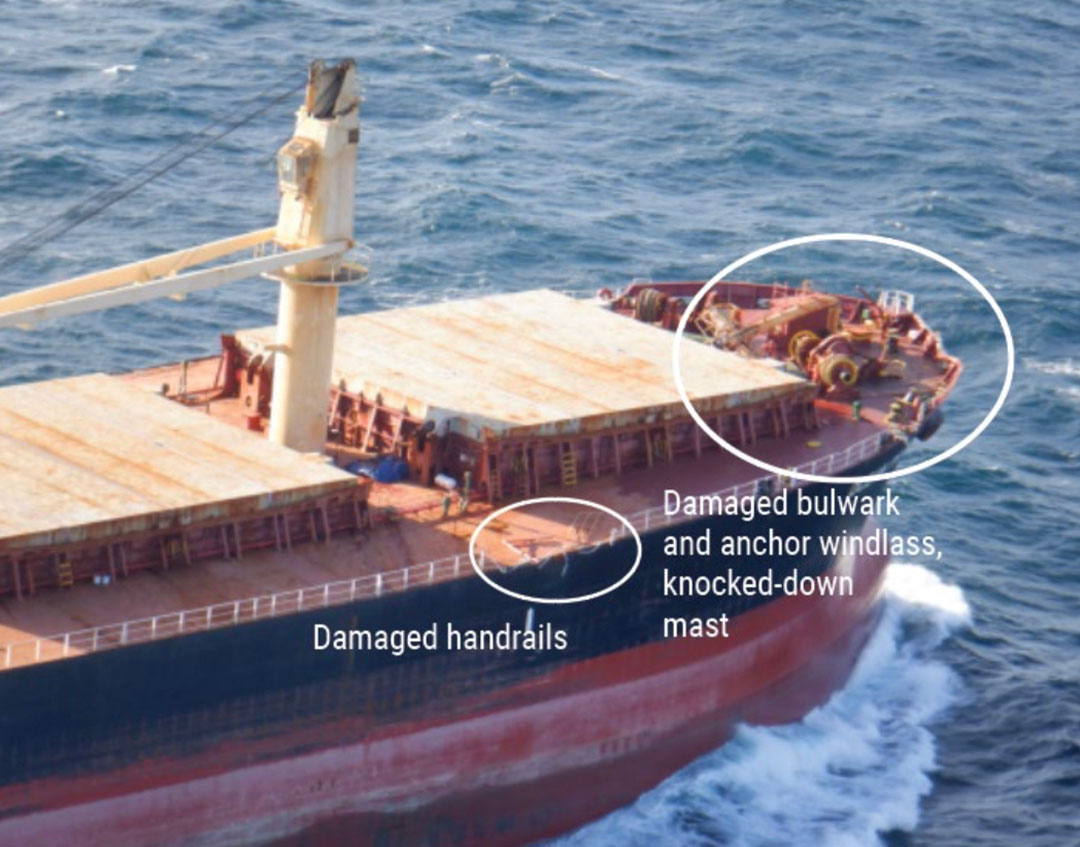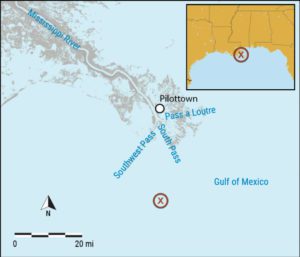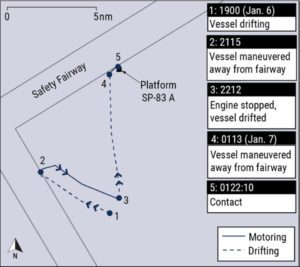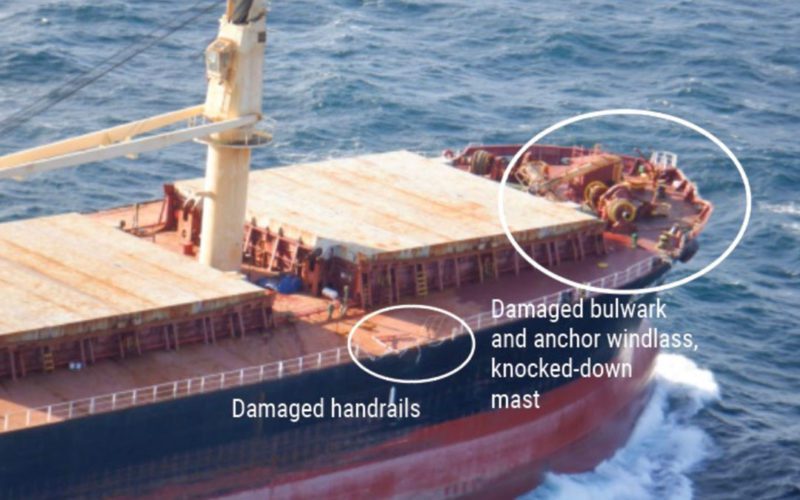
Poor bridge resource management was the leading cause of an incident in the Gulf of Mexico where a bulk carrier struck an uncrewed oil and gas platform, according to federal investigators.
 The 623-foot Ocean Princess struck SP-83A, located 24 miles south of Pilottown, La., on Jan. 7, 2021, at 0122. No one was injured but the ship sustained about $500,000 in damage. The platform, which was not in service, required $1 million in repairs. There was no pollution.
The 623-foot Ocean Princess struck SP-83A, located 24 miles south of Pilottown, La., on Jan. 7, 2021, at 0122. No one was injured but the ship sustained about $500,000 in damage. The platform, which was not in service, required $1 million in repairs. There was no pollution.
National Transportation Safety Board (NTSB) investigators determined the ship’s master and third mate noticed lights from the platform roughly 10 minutes before the incident. However, they mistook it for another platform farther away and made no effort to steer around it.
Platform SP-83A did not appear on National Oceanic and Atmospheric Administration (NOAA) charts accessed on the ship’s electronic chart display and information system (ECDIS), although it did appear on British paper charts used by the crew. This NOAA charting error, which has been corrected, contributed to the incident.
The primary cause, investigators said, “was poor bridge resource management, which resulted in the bridge team not identifying the platform and recognizing the risk it posed to their safe navigation,” the NTSB report said.
Fatigue and distraction might have contributed to the outcome. The NTSB determined that Ocean Princess’ master had 3.5 hours of rest in the 20 hours preceding the incident. He also spent about 25 minutes leading up to the casualty engaged in a “mostly one-sided” conversation with the second officer “about non-navigational, non-pertinent matters.”
This conversation finally ended, the report said, about a minute before the ship’s bow struck the platform.
The Hong Kong-flagged Ocean Princess finished discharging its cargo at Harmony Street Wharf in New Orleans on Jan. 6. It departed the terminal for the Gulf of Mexico, where it was to drift for a day or two while crewmembers cleaned the holds. Then it would return to the New Orleans area to load grain for export.

The ship reached the area where it would drift at about 1630. The master ordered the engine stopped and turned over the conn to the chief mate with instructions to keep the engine on 15-minute standby for maneuvering. The master’s night orders also called for the mate on watch to keep clear of traffic and platforms. Two safety fairways and three platforms, including SP-83A, were in the general vicinity.
The master scheduled himself to be on the bridge from 2000 to 0400 to give crewmembers a rest after spending the day cleaning the holds. During that time, the master reviewed stability calculations for cargo loading the following day. He also made a phone call to the home office.
The vessel maneuvered under engine power from about 2108 to 2212 to avoid a safety fairway. The second officer called the engine room to prepare the engine at 0100 on Jan. 7 as the ship drifted toward another fairway. The master took the conn at about 0110 and three minutes later ordered the engine dead slow ahead.
“At the same time,” the report said, “the master stated he saw a dim yellow light, so he checked the radar. Not seeing any contacts, he checked the ECDIS and thought the light was from an oil platform 5 to 6 miles away, roughly on the same bearing.”
The second officer used binoculars and could not determine how far the light was from the vessel. He, too, thought the light was about 5 miles away after checking the ECDIS. He did not look at the radar.
Visibility was variable at the time, roughly 2 nautical miles with cloudy skies and rain. Winds gusted up to 25 knots and seas were 8 to 10 feet, the NTSB report said.
The master ordered the engine to slow ahead at 0116 and then to half ahead at 0121. Meanwhile, he realized the light was coming closer to the ship. At that point, the master ran to a bridge window and saw multiple flashing lights. He ordered the rudder hard to starboard and the engine full ahead, but 10 seconds later, at 0122:10, the ship’s starboard bow hit the platform at about 4 knots.
Ocean Princess was unable to maneuver away from the platform because the ship’s starboard anchor was caught on the structure. Crew severed the anchor chain about seven hours later.
The ECDIS aboard the ship displayed charts from a NOAA database. Although platform SP-83A initially appeared on relevant paper charts 11361 and 11366, it “disappeared” from them in March 2010. Those charts with the omitted platform were then used in the creation of electronic charts used by the ship, the NTSB explained.
NOAA’s switch from paper charts to electronic charts has created a new process for updating, reviewing and correcting chart data. Based on that new process, “NOAA believes … the error of SP-83A being omitted from (electronic) charts could not happen today,” the report said.
The NTSB identified a series of missteps that led to the ship striking the platform. Only one radar was active and set at a range of 1.5 miles, thus explaining why the master did not see the platform on the radar. The ship’s second radar was in standby mode.
Crew also failed to verify the source of the lights roughly 10 minutes before impact, with both the master and second mate making assumptions that proved incorrect.
The second mate, who had plotted fixes on the paper chart before the impact, was aware of the platform’s presence in the area. He did not specifically tell the master about it, the report said, because he assumed the master knew it was there. As such, neither was aware how close the ship was to the platform.
“Despite identifying SP-83A on the paper chart, the mate on watch discounted this information and did not communicate it with the master,” the report said. “This concept is called confirmation bias.
“When the bridge team saw multiple lights one minute before the casualty, they realized a contact was close to the vessel,” the report continued. “They did not identify that the object they struck was a stationary platform until a few minutes after contact.”
Ocean Princess dropped its remaining anchor in a nearby anchorage while crew assessed the damage. On Jan. 8, the ship sailed to a berth in New Orleans.

